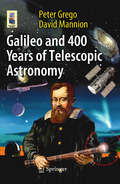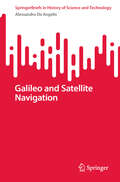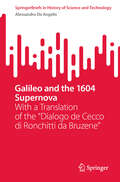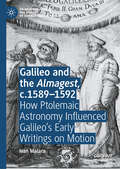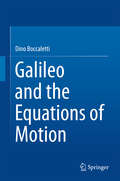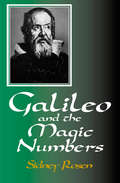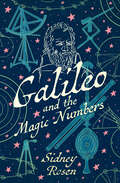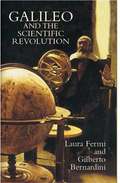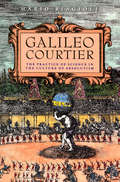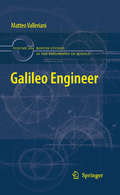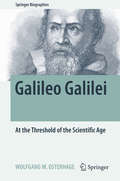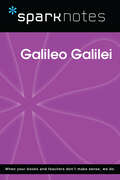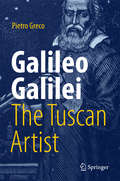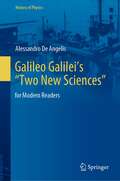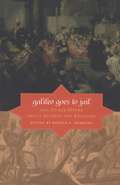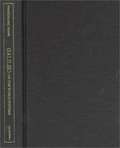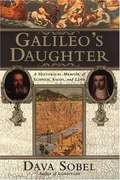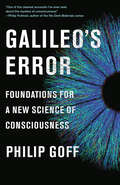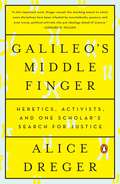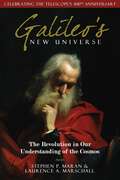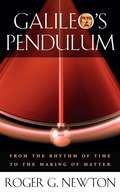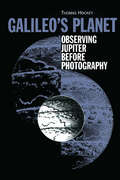- Table View
- List View
Galileo and 400 Years of Telescopic Astronomy
by David Mannion Peter GregoIn 1609 Galileo first used his telescope to kick start the science of observational astronomy - an event that proved to be of enormous historic, scientific, and cultural importance. Galileo and 400 Years of Telescopic Astronomy will feature the life and achievements of Galileo, around which has pivoted the story of four centuries of telescopic astronomy. The book will detail how astronomy has progressed through four centuries and contain glimpses of future space research and astronomy goals. Uniquely, interwoven with the text will be a range of practical projects for backyard astronomers in which to participate, projects that serve to illustrate many of Galileo's scientific discoveries.
Galileo and Satellite Navigation (SpringerBriefs in History of Science and Technology)
by Alessandro De AngelisThis book explores the Galilean method for geolocation, placing it in historical and astronomical context. It bridges the techniques developed by the Greeks and medieval astronomers with later innovations like precision clocks, 20th-century wireless technology, and space-based navigation. The primary source is the twenty-volume National Edition of the Works of Galileo (published 1890-1909 by Antonio Favaro) and the update edited by Michele Camerota and Patrizia Ruffo in 2019, which includes previously unpublished documents on Galileo's negotiations with the Spanish government for selling his longitude-determining method at sea. This book inspired the 2024 "International Research Day in the World," focused on geolocation, organized by the Italian Permanent Delegation to International Organizations in Paris. In collaboration with Museo Galileo in Florence and Sorbonne Université, the event featured the exhibition “Galileo and Satellite Navigation,” showcased at the Pierre et Marie Curie Campus in Paris (June 13-28, 2024), and later at the Italian Institutes of Culture in Prague and Amsterdam, and at the Perimeter Institute in Waterloo, Canada.
Galileo and the 1604 Supernova: With a Translation of the "Dialogo de Cecco di Ronchitti da Bruzene" (SpringerBriefs in History of Science and Technology)
by Alessandro De AngelisThis book is about the 1604 supernova and presents the translation of key documents discussing this astronomical event in Italy. Only seven Galactic supernovae visible to the naked eye are documented, with the 1604 event, the last in history, profoundly impacting astronomy, cosmology, and culture in general. The 1604 supernova challenged the prevailing belief in the unchanging nature of stars. Astronomers like Galileo and Kepler, alongside counterparts from Arab, Chinese, and Korean backgrounds, collaborated to explain its origin, analyzing astronomical and astrological signals five years before the invention of the telescope. Galileo, approached for interpretation while teaching in Padua, cautiously expressed his views in three unpublished lectures, a pseudonymous treatise written in Paduan dialect, and a poem immediately withdrawn, sparking a dispute with Aristotelian scholars in Italy. The 1604 supernova, a pivotal historical event, spurred collaborative efforts and debates, reshaping perceptions of the cosmos. This debate dominated science from 1604 to 1606, preceding Kepler's treatise {\em De Stella Nova}. Remnants of the explosion of the supernova, called today Kepler’s supernova, are still visible and are the subject of studies by modern observatories and discussions in the astrophysical community.
Galileo and the Almagest, c.1589–1592: How Ptolemaic Astronomy Influenced Galileo’s Early Writings on Motion (Palgrave Studies in the History of Science and Technology)
by Ivan MalaraThis book offers a groundbreaking exploration of Galileo Galilei’s engagement with the Almagest, Claudius Ptolemy’s second-century scientific work on the motions of stars and planetary paths. Contrary to the belief that Galileo had little interest in Ptolemaic astronomy, the author investigates whether Ptolemy influenced Galileo’s shift to Copernicanism, the theory that Earth and all other planets revolve around the Sun. This inquiry is pursued through a detailed examination of Galileo’s early writings on motion, namely the so-called De motu antiquiora (c. 1589–1592). By contextualizing Galileo’s initial reception of Ptolemy, the book reveals a fascinating historical backdrop, highlighting how the Almagest was intended to be read and studied in Galileo’s milieu during the last decades of the sixteenth century. The author challenges the conventional ‘Ptolemaic-Aristotelian’ label by showing that early Galileo adhered to a Ptolemaic, yet non-Aristotelian, cosmology supported by an Archimedean-like rationale. Additionally, the book underscores the often-overlooked impact of Theon of Alexandria’s commentary on the Almagest in the sixteenth- and seventeenth-century reception of Ptolemy, suggesting it as one of Galileo’s potential sources. Offering valuable insights for historians of science and early modern astronomy, this book illuminates Galileo’s intricate relationship with astronomical and philosophical ideas, emphasizing the need to re-examine his intellectual journey within a nuanced historical framework.
Galileo and the Equations of Motion
by Dino BoccalettiThis book is intended as a historical and critical study on the origin of the equations of motion as established in Newton's Principia. The central question that it aims to answer is whether it is indeed correct to ascribe to Galileo the inertia principle and the law of falling bodies. In order to accomplish this task, the study begins by considering theories on the motion of bodies from classical antiquity, and especially those of Aristotle. The theories developed during the Middle Ages and the Renaissance are then reviewed, with careful analysis of the contributions of, for example, the Merton and Parisian Schools and Galileo's immediate predecessors, Tartaglia and Benedetti. Finally, Galileo's work is examined in detail, starting from the early writings. Excerpts from individual works are presented, to allow the texts to speak for themselves, and then commented upon. The book provides historical evidence both for Galileo's dependence on his forerunners and for the major breakthroughs that he achieved. It will satisfy the curiosity of all who wish to know when and why certain laws have been credited to Galileo.
Galileo and the Magic Numbers
by Sidney RosenSixteenth century Italy produced a genius who marked the world with his studies and hypotheses about mathematical, physical and astronomical truths. His father, musician Vincenzio Galilei said, &“Truth is not found behind a man&’s reputation. Truth appears only when the answers to questions are searched out by a free mind. This is not the easy path in life but it is the most rewarding.&” Galileo challenged divine law and the physics of Aristotle, and questioned everything in search of truths. And it was through this quest for truth that he was able to establish a structure for modern science.
Galileo and the Magic Numbers
by Sidney RosenThis &“enjoyable&” biography of the brilliant astronomer will intrigue young people who are &“bored with the textbook approach to science&” (The New York Times Book Review). Sixteenth century Italy produced Galileo, a genius who marked the world with his studies and hypotheses about mathematical, physical, and astronomical truths. His father, musician Vincenzio Galilei said, &“Truth is not found behind a man&’s reputation. Truth appears only when the answers to questions are searched out by a free mind. This is not the easy path in life but it is the most rewarding.&” Galileo challenged divine law and the physics of Aristotle, and questioned everything in search of truths. And it was through this quest for truth that he was able to establish a structure for modern science.
Galileo and the Scientific Revolution
by Laura Fermi Gilberto BernardiniAn absorbing account of the origins of modern science as well as a biography of the revolutionary thinker, this inspiring book was co-written by a former director of the Italian Institute for Nuclear Physics and a historian of science (who was also the wife of physicist Enrico Fermi). It begins in Galileo's youth, with his return to his native city of Pisa to train as a physician. Instead, the student became captivated by the power of mathematical reasoning — an interest that led him to apply mathematical logic to natural events and, ultimately, to invent the concept of experimentation. Galileo's progress from student to teacher to scientific innovator is traced, with particular emphasis on his experiments with building and refining telescopes and his unprecedented observations of the moon and planets. The dramatic results of his findings, including his refutation of Aristotelian theory and his support of Copernican doctrine, are related in full, along with his clash with the papal inquisition and his tragic demise under house arrest. Written with a warm appreciation for the wonders of Galileo's achievements and with impeccable scholarship, this book concludes with a survey of the scientist's remarkable legacy. 12 figures. Appendix. Bibliography. Index.
Galileo Courtier: The Practice of Science in the Culture of Absolutism (Science and Its Conceptual Foundations series)
by Mario BiagioliInformed by currents in sociology, cultural anthropology, and literary theory, Galileo, Courtier is neither a biography nor a conventional history of science. In the court of the Medicis and the Vatican, Galileo fashioned both his career and his science to the demands of patronage and its complex systems of wealth, power, and prestige. Biagioli argues that Galileo's courtly role was integral to his science—the questions he chose to examine, his methods, even his conclusions.Galileo, Courtier is a fascinating cultural and social history of science highlighting the workings of power, patronage, and credibility in the development of science.
Galileo Engineer
by Matteo VallerianiThis work systematically investigates and reconstructs the practical knowledge Galileo shared during his lifetime. Galileo shared many aspects of practical knowledge. These included the methods and experience of foremen and engineers active within various frameworks. Galileo did not always react to such scientific impulses in the same way. On the one hand, he not only shared practical knowledge, but also acted as an engineer, especially within the framework of the art of war at the end of the sixteenth century, and more so during the time he spent in Padua. On the other hand, his scientific achievements were largely based on and influenced by aspects of practical knowledge coming from particular disciplines and activities, without him ever becoming an expert in these disciplines. Two case studies, the first concerned with Galileo's theory of the strength of materials and the second with his achievement of an atomistic heat doctrine, enable a focus on the early modern model of generation of new scientific knowledge based on the conflicting interaction between aspects of practical knowledge and Aristotelian theoretical assumptions.
Galileo for Kids: His Life and Ideas, 25 Activities (For Kids series)
by Buzz Aldrin Richard PanchykGalileo, one of history's best-known scientists, is introduced in this illuminating activity book. Children will learn how Galileo's revolutionary discoveries and sometimes controversial theories changed his world and laid the groundwork for modern astronomy and physics. This book will inspire kids to be stargazers and future astronauts or scientists as they discover Galileo's life and work. Activities allow children to try some of his theories on their own, with experiments that include playing with gravity and motion, making a pendulum, observing the moon, and painting with light and shadow. Along with the scientific aspects of Galileo's life, his passion for music and art are discussed and exemplified by period engravings, maps, and prints. A time line, glossary, and listings of major science museums, planetariums, and web sites for further exploration complement this activity book.
Galileo Galilei: At the Threshold of the Scientific Age (Springer Biographies)
by Wolfgang W. OsterhageThis new scientific biography explores the influences on, and of, Galileo’s exceptional work, thereby revealing novel connections with the worldviews of his age and beyond.Galileo Galilei's contribution to science is unquestionable. And his conflict with the church establishment of his time is no less famous. In this book, authored by a physicist and history scholar, Galileo's life and work are described against a backdrop of the prior scientific state of the art in his various fields of achievement. Particular emphasis is placed on Galileo's vision of the world in relation to historic and also future cosmological models. The impact of his discoveries and theories for the later development of physics and astronomy is a further focus of the narrative.
Galileo Galilei (SparkNotes Biography Guide)
by SparkNotesGalileo Galilei (SparkNotes Biography Guide) Making the reading experience fun! SparkNotes Biography Guides examine the lives of historical luminaries, from Alexander the Great to Virginia Woolf. Each biography guide includes:An examination of the historical context in which the person lived A summary of the person&’s life and achievements A glossary of important terms, people, and events An in-depth look at the key epochs in the person&’s career Study questions and essay topics A review test Suggestions for further reading Whether you&’re a student of history or just a student cramming for a history exam, SparkNotes Biography guides are a reliable, thorough, and readable resource.
Galileo Galilei, The Tuscan Artist
by Pietro GrecoProvides a very original biography of the pioneer of modern science.<P> Covers all aspects: the scientific, the artistic, the philosophical, and the theological.<P> Describes the cultural atmosphere in which modern science was born Details the causes of the difficult relationships between modern science and the Catholic Church.<P> This book is a distinctively original biography of Galileo Galilei, probably the last eclectic genius of the Italian Renaissance, who was not only one of the greatest scientists ever, but also a philosopher, a theologian, and a man of great literary, musical, and artistic talent – “The Tuscan Artist”, as the poet John Milton referred to him. Galileo was exceptional in simultaneously excelling in the Arts, Science, Philosophy, and Theology. These diverse aspects of his life were closely intertwined; indeed, it may be said that he personally demonstrated that human culture is not divisible, but rather one, with a thousand shades. Galileo also represented the bridge between two historical epochs. As the philosopher Tommaso Campanella, a contemporary of Galileo, recognized at the time, Galileo was responsible for ushering in a new age, the Modern Age. This book, which is exceptional in the completeness of its coverage, explores all aspects of the life of Galileo, as a Tuscan artist and giant of the Renaissance, in a stimulating and reader-friendly way.
Galileo Galilei’s “Two New Sciences”: for Modern Readers (History of Physics)
by Alessandro De AngelisThis book aims to make Galileo Galilei (1564-1642) accessible to the modern reader by refashioning the great scientist's masterpiece "Discourses and Mathematical Demonstrations Relating to Two New Sciences" in today's language. Galileo Galilei stands as one of the most important figures in history, not simply for his achievements in astronomy, physics, and engineering and for revolutionizing science and the scientific method in general, but also for the role that he played in the (still ongoing) drama concerning entrenched power and its desire to stifle any knowledge that may threaten it. Therefore, it is important that today's readers come to understand and appreciate what Galilei accomplished and wrote. But the mindset that shapes how we see the world today is quite different from the mindset -- and language -- of Galilei and his contemporaries. Another obstacle to a full understanding of Galilei's writings is posed by the countless historical, philosophical, geometrical, and linguistic references he made, along with his often florid prose, with its blend of Italian and Latin. De Angelis' new rendition of the work includes translations of the original geometrical figures into algebraic formulae in modern notation and allows the non-specialist reader to follow the thread of Galileo's thought and in a way that was barely possible until now.
Galileo goes to Jail and other Myths about Science and Religion
by Ronald L. NumbersA new generation of historians both of science and of the church began to examine episodes in the history of science and religion through the values and knowledge of the actors themselves. Now Ronald Numbers has recruited the leading scholars in this new history of science to puncture the myths, from Galileo's incarceration to Darwin's deathbed conversion to Einstein's belief in a personal God who didn't play dice with the universe.
Galileo on the World Systems: A New Abridged Translation and Guide
by Maurice A. FinocchiaroGalileo's 1632 book, Dialogue on the Two Chief World Systems, Ptolemaic and Copernican, comes alive for twentieth-century readers thanks to Maurice Finocchiaro's brilliant new translation and presentation. Galileo on the World Systems is a remarkably nuanced interpretation of a classic work and will give readers the tools to understand and evaluate for themselves one of the most influential scientific books in Western civilization.
Galileo's Daughter: A Historical Memoir of Science, Faith and Love
by Dava SobelThe author of Longitude presents a biography of the man Einstein called the father of modern physics, and the Church long branded a heretic, as revealed through the newly translated letters of his confidante daughter. Includes b&w illustrations of featured personalities, locales, and scientific paraphernalia, and a chronology demonstrating Galileo's legacy through the present.
Galileo's Error: Foundations for a New Science of Consciousness
by Philip GoffFrom a leading philosopher of the mind comes this lucid, provocative argument that offers a radically new picture of human consciousness—panpsychism.Understanding how brains produce consciousness is one of the great scientific challenges of our age. Some philosophers argue that consciousness is something "extra," beyond the physical workings of the brain. Others think that if we persist in our standard scientific methods, our questions about consciousness will eventually be answered. And some even suggest that the mystery is so deep, it will never be solved. Decades have been spent trying to explain consciousness from within our current scientific paradigm, but little progress has been made.Now, Philip Goff offers an exciting alternative that could pave the way forward. Rooted in an analysis of the philosophical underpinnings of modern science and based on the early twentieth-century work of Arthur Eddington and Bertrand Russell, Goff makes the case for panpsychism, a theory which posits that consciousness is not confined to biological entities but is a fundamental feature of all physical matter—from subatomic particles to the human brain. In Galileo's Error, he has provided the first step on a new path to the final theory of human consciousness.
Galileo's Middle Finger
by Alice DregerJared Diamond, author of Guns, Germs, and Steel and The World until Yesterday"Alice Dreger would win a prize for this year's most gripping novel, except for one thing: her stories are true, and this isn't a novel. Instead, it's an exciting account of complicated good guys and bad guys, and the pursuit of justice."An impassioned defense of intellectual freedom and a clarion call to intellectual responsibility, Galileo's Middle Finger is one American's eye-opening story of life in the trenches of scientific controversy. For two decades, historian Alice Dreger has led a life of extraordinary engagement, combining activist service to victims of unethical medical research with defense of scientists whose work has outraged identity politics activists. With spirit and wit, Dreger offers in Galileo's Middle Finger an unforgettable vision of the importance of rigorous truth seeking in today's America, where both the free press and free scholarly inquiry struggle under dire economic and political threats.This illuminating chronicle begins with Dreger's own research into the treatment of people born intersex (once called hermaphrodites). Realization of the shocking surgical and ethical abuses conducted in the name of "normalizing" intersex children's gender identities moved Dreger to become an internationally recognized patient rights' activist. But even as the intersex rights movement succeeded, Dreger began to realize how some fellow progressive activists were employing lies and personal attacks to silence scientists whose data revealed uncomfortable truths about humans. In researching one such case, Dreger suddenly became the target of just these kinds of attacks.Troubled, she decided to try to understand more--to travel the country to ferret out the truth behind various controversies, to obtain a global view of the nature and costs of these battles. Galileo's Middle Finger describes Dreger's long and harrowing journeys between the two camps for which she felt equal empathy: social justice activists determined to win and researchers determined to put hard truths before comfort. Ultimately what emerges is a lesson about the intertwining of justice and of truth--and a lesson of the importance of responsible scholars and journalists to our fragile democracy.Booklist (starred review)"A crusader in the mold of muckrackers from a century ago, Dreger doesn't try to hide her politics or her agenda. Instead she advocates for change intelligently and passionately. Highly recommended."Kirkus (starred review): "Let us be grateful that there are writers like Dreger who have the wits and the guts to fight for truth." Dan Savage, founder of "It Gets Better" Project; author of American Savage: "If there ever there were a book that showed how democracy requires smart activism and solid data--and how that kind of work can be defeated by moneyed interests, conservative agendas, inept governments, and duplicitous "activists"--this is it. Galileo's Middle Finger reads like a thriller. The cliché applies: I literally couldn't put it down. Alice Dreger leaves you wondering what's going to happen to America if our universities continue to turn into corporate brands afraid of daring research and unpopular ideas about who we are."
Galileo's Middle Finger: Heretics, Activists, and the Search for Justice in Science
by Alice DregerNew York Times Book Review "[S]mart, delightful... a splendidly entertaining education in ethics, activism and science."Editors's Choice, New York Times Book ReviewAn impassioned defense of intellectual freedom and a clarion call to intellectual responsibility, Galileo's Middle Finger is one American's eye-opening story of life in the trenches of scientific controversy. For two decades, historian Alice Dreger has led a life of extraordinary engagement, combining activist service to victims of unethical medical research with defense of scientists whose work has outraged identity politics activists. With spirit and wit, Dreger offers in Galileo's Middle Finger an unforgettable vision of the importance of rigorous truth seeking in today's America, where both the free press and free scholarly inquiry struggle under dire economic and political threats.This illuminating chronicle begins with Dreger's own research into the treatment of people born intersex (once called hermaphrodites). Realization of the shocking surgical and ethical abuses conducted in the name of "normalizing" intersex children's gender identities moved Dreger to become an internationally recognized patient rights' activist. But even as the intersex rights movement succeeded, Dreger began to realize how some fellow progressive activists were employing lies and personal attacks to silence scientists whose data revealed uncomfortable truths about humans. In researching one such case, Dreger suddenly became the target of just these kinds of attacks.Troubled, she decided to try to understand more--to travel the country to ferret out the truth behind various controversies, to obtain a global view of the nature and costs of these battles. Galileo's Middle Finger describes Dreger's long and harrowing journeys between the two camps for which she felt equal empathy: social justice activists determined to win and researchers determined to put hard truths before comfort. Ultimately what emerges is a lesson about the intertwining of justice and of truth--and a lesson of the importance of responsible scholars and journalists to our fragile democracy.Booklist (starred review)"A crusader in the mold of muckrackers from a century ago, Dreger doesn't try to hide her politics or her agenda. Instead she advocates for change intelligently and passionately. Highly recommended."Kirkus (starred review): "Let us be grateful that there are writers like Dreger who have the wits and the guts to fight for truth." Jared Diamond, author of Guns, Germs, and Steel and The World until Yesterday"Alice Dreger would win a prize for this year's most gripping novel, except for one thing: her stories are true, and this isn't a novel. Instead, it's an exciting account of complicated good guys and bad guys, and the pursuit of justice."From the Hardcover edition.
Galileo's New Universe: The Revolution in Our Understanding of the Cosmos
by Stephen P. Maran Laurence A. MarschallThe historical and social implications of the telescope and that instrument's modern-day significance are brought into startling focus in this fascinating account. When Galileo looked to the sky with his perspicillum, or spyglass, roughly 400 years ago, he could not have fathomed the amount of change his astonishing findings-a seemingly flat moon magically transformed into a dynamic, crater-filled orb and a large, black sky suddenly held millions of galaxies-would have on civilizations. Reflecting on how Galileo's world compares with contemporary society, this insightful analysis deftly moves from the cutting-edge technology available in 17th-century Europe to the unbelievable phenomena discovered during the last 50 years, documenting important astronomical advances and the effects they have had over the years.
Galileo’s Pendulum: From the Rhythm of Time to the Making of Matter
by Roger G. NewtonBored during Mass at the cathedral in Pisa, the seventeen-year-old Galileo regarded the chandelier swinging overhead—and remarked, to his great surprise, that the lamp took as many beats to complete an arc when hardly moving as when it was swinging widely. Galileo’s Pendulum tells the story of what this observation meant, and of its profound consequences for science and technology. The principle of the pendulum’s swing—a property called isochronism—marks a simple yet fundamental system in nature, one that ties the rhythm of time to the very existence of matter in the universe. Roger Newton sets the stage for Galileo’s discovery with a look at biorhythms in living organisms and at early calendars and clocks—contrivances of nature and culture that, however adequate in their time, did not meet the precise requirements of seventeenth-century science and navigation. Galileo’s Pendulum recounts the history of the newly evolving time pieces—from marine chronometers to atomic clocks—based on the pendulum as well as other mechanisms employing the same physical principles, and explains the Newtonian science underlying their function. The book ranges nimbly from the sciences of sound and light to the astonishing intersection of the pendulum’s oscillations and quantum theory, resulting in new insight into the make-up of the material universe. Covering topics from the invention of time zones to Isaac Newton’s equations of motion, from Pythagoras’s theory of musical harmony to Michael Faraday’s field theory and the development of quantum electrodynamics, Galileo’s Pendulum is an authoritative and engaging tour through time of the most basic all-pervading system in the world.
Galileo's Planet: Observing Jupiter Before Photography
by Thomas A HockeySince the earliest times one of the brightest lights in the heavens has been that of Jupiter, mythical king of the gods and the largest planet in the solar system. It was only natural that peoples from the dawn of history would be interested in such a planet and, indeed, Jupiter was one of the first objects to be observed with the telescope. Even today Jupiter captures the public interest like no other planet: a vast gaseous world, home to violent storms (larger than the Earth) that have raged for centuries.Galileo's Planet: Observing Jupiter before Photography presents the history of humankind's quest to understand the giant planet in the era before photography, a time when the only way to observe the universe was with the human eye. The book provides a comprehensive and fascinating account of the people involved in this quest, their observations, and the results of their findings. Many of the planetary features studied in detail by today's space probes were once glimpsed by keen-eyed, amateur astronomers. These Earth-bound explorers made up for their modest instruments and viewing conditions with their patience, perseverance, and passion for the night sky. Their greatest challenge was the fifth planet from the Sun and the search for its imagined surface-a revelation of the "real Jupiter." In the process, these part-time observers redefined the meaning of the word "planet." The book recounts their story from the earliest times right up until the invention of the camera.
Galileo's Reading
by Crystal HallGalileo (1564–1642) incorporated throughout his work the language of battle, the rhetoric of the epic, and the structure of romance as a means to elicit emotional responses from his readers against his opponents. By turning to the literary as a field for creating knowledge, Galileo delineated a textual space for establishing and validating the identity of the new, idealized philosopher. Galileo's Reading places Galileo in the complete intellectual and academic world in which he operated, bringing together, for example, debates over the nature of floating bodies and Ludovico Ariosto's Orlando furioso, disputes on comets and the literary criticism of Don Quixote, mathematical demonstrations of material strength and Dante's voyage through the afterlife, and the parallels of his feisty note-taking practices with popular comedy of the period.
